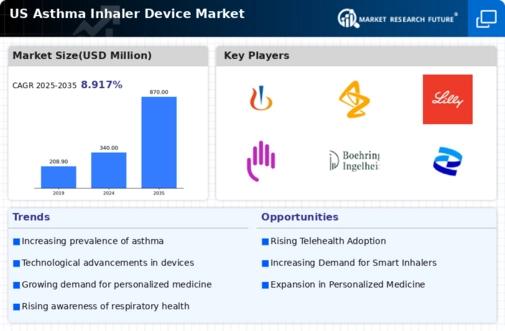Rising Asthma Prevalence
The increasing prevalence of asthma in the US is a primary driver for the asthma inhaler-device market. Recent estimates indicate that approximately 25 million Americans are affected by asthma, which translates to about 8% of the population. This growing number of patients necessitates a corresponding rise in the demand for inhaler devices. As awareness of asthma management improves, patients are more likely to seek effective treatment options, thereby propelling the market forward. Furthermore, the asthma inhaler-device market is expected to witness a compound annual growth rate (CAGR) of around 5% over the next few years, driven by this rising prevalence. The need for innovative inhaler solutions that cater to diverse patient needs is becoming increasingly apparent, suggesting a robust market potential for manufacturers.
Growing Awareness and Education
Growing awareness and education regarding asthma management are pivotal in driving the asthma inhaler-device market. Public health campaigns and educational initiatives aimed at both patients and healthcare providers are enhancing understanding of asthma and its treatment options. This increased awareness is leading to higher rates of diagnosis and treatment adherence, which in turn boosts the demand for inhaler devices. Additionally, educational programs focusing on proper inhaler technique are essential for maximizing the effectiveness of these devices. As patients become more informed about their condition and the importance of effective management, the asthma inhaler-device market is expected to experience sustained growth. This trend highlights the critical role of education in improving health outcomes for asthma patients.
Increased Healthcare Expenditure
The rising healthcare expenditure in the US is another significant driver for the asthma inhaler-device market. With healthcare spending projected to reach approximately $4.3 trillion by 2025, there is a growing emphasis on chronic disease management, including asthma. This increase in spending facilitates better access to advanced inhaler devices and treatment options for patients. Moreover, insurance coverage for asthma medications and devices is improving, which further encourages patients to invest in high-quality inhalers. As healthcare systems prioritize effective asthma management, the asthma inhaler-device market is likely to benefit from increased funding and resources allocated to respiratory care. This trend suggests a favorable environment for market growth in the coming years.
Regulatory Support for Innovative Devices
Regulatory support for innovative asthma inhaler devices is a key driver in the market. The US Food and Drug Administration (FDA) has been actively promoting the development of new inhaler technologies that enhance patient outcomes. Streamlined approval processes for novel inhalers, particularly those incorporating digital health features, are encouraging manufacturers to invest in research and development. This regulatory environment fosters innovation and allows for the introduction of more effective and user-friendly inhaler devices. As a result, the asthma inhaler-device market is likely to see a proliferation of new products that meet the evolving needs of patients. This regulatory support not only stimulates market growth but also enhances the overall quality of asthma care.
Technological Advancements in Inhaler Devices
Technological advancements play a crucial role in shaping the asthma inhaler-device market. Innovations such as smart inhalers, which utilize digital health technologies, are gaining traction among consumers and healthcare providers. These devices often feature connectivity options that allow for real-time monitoring of medication usage, which can enhance patient adherence to treatment regimens. The integration of mobile applications with inhalers is also becoming more common, providing users with valuable insights into their asthma management. As a result, the market is likely to see a surge in demand for these technologically advanced inhalers, which are projected to account for a significant share of the overall market by 2027. This trend indicates a shift towards more personalized and effective asthma management solutions.

















Leave a Comment